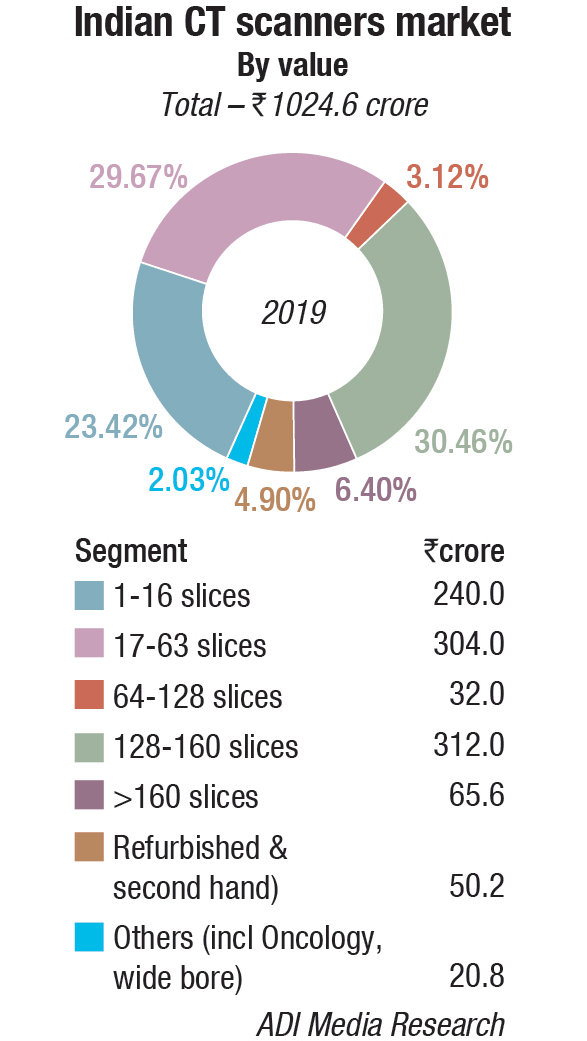CT Scanners
COVID-19 prompts procurement of CT scanners
CT scans are not a substitute for RT-PCR, the reference standard for COVID-19. Yet their role in assessing the damage and deciding the treatment once the test is positive cannot be denied.
 The pandemic has pushed up the demand for CT scan machines, which are now being increasingly used as an early tool to differentiate the COVID-19 pneumonia from others. COVID-induced pneumonia has been seen in almost all infected, even in aysmptomatic patients. An AI-based algorithm has been developed by most vendors and plugged in most of the installations, for it takes a look at the scan and calculates the pneumonia score, indicating the severity of the pneumonia, determining how to manage the patient.
The pandemic has pushed up the demand for CT scan machines, which are now being increasingly used as an early tool to differentiate the COVID-19 pneumonia from others. COVID-induced pneumonia has been seen in almost all infected, even in aysmptomatic patients. An AI-based algorithm has been developed by most vendors and plugged in most of the installations, for it takes a look at the scan and calculates the pneumonia score, indicating the severity of the pneumonia, determining how to manage the patient.
CT scan is a clear differentiator. The COVID-19 CT scan has something called ground-glass opacity, that indicates if the patient needs to be isolated even before the confirmatory RT-PCR report comes, thus preventing a lot of collateral damage. Chest X-rays and CT scans are critical imaging tools used in evaluating the respiratory complications related to coronavirus too. When patients are placed on ventilators for breathing assistance, radiologic technologists use imaging procedures so appropriate placement can be verified.
Given the severity of the pandemic and the damage that it is causing, it may be prudent to do routine CT plus RT-PCR testing for COVID-19.
Demand has shot up
Of the new CT installations, 16-slice CT is used mainly for COVID-19 management, 60-70 per cent being in new sites where CT services did not exist, and these include tier II towns. A lot of smaller nursing homes and hospitals are now buying CT machines as they realise that each COVID-19 patient would need to be scanned at least once during hospital stay. There is imperatively the need to use computers and rotating X-ray machines to create cross-sectional images of the body, at some point to monitor the progression of the disease.
Corporate hospitals are also buying CT machines. They find that while a CT scan takes 15 minutes, it takes 45 minutes to sanitise one after each patient. Industry studies estimate that about 30 percent of a hospital’s revenue is derived from imaging. More than ever, facilities need to optimize the use of their imaging facilities to protect the bottom line.
Vendors at their end have resorted to getting their shipments by air, as compared to the sea route used earlier. Another distinct development is the remote-use feature added in the machines so that the technician does not necessarily need to be present in the CT scan room to operate the machine.
 “With the third wave of the coronavirus pandemic presenting an unprecedented public health situation, there is a growing demand for CT to aid in the diagnosis and aid in treatment planning of patients and minimise cross-infection. To meet these challenges, the newest available option is CT-in-a-box consisting of two small prefabricated cabins with a shielded partition wall between the exam and control rooms, complete with lead shielding for radiation protection; HVAC unit for ventilation and temperature control; in-built power distribution system and easy to sanitise construction material. The pessimist complains about the wind; the optimist expects it to change; the realist adjusts the sails!”
“With the third wave of the coronavirus pandemic presenting an unprecedented public health situation, there is a growing demand for CT to aid in the diagnosis and aid in treatment planning of patients and minimise cross-infection. To meet these challenges, the newest available option is CT-in-a-box consisting of two small prefabricated cabins with a shielded partition wall between the exam and control rooms, complete with lead shielding for radiation protection; HVAC unit for ventilation and temperature control; in-built power distribution system and easy to sanitise construction material. The pessimist complains about the wind; the optimist expects it to change; the realist adjusts the sails!”
Dr Anurag Yadav
Sr Consultant, Department of CT & MRI, Sir Ganga Ram Hospital
As for scanner contamination, cleaning techniques have gained importance. In China, for instance, normal cleaning protocol allowed for the safe scanning of 200 patients each day on a single scanner with multiple clinics documenting zero transmissions to CT suite staff. This was one of many integral and necessary adaptations that yielded inarguable success. Their curve swiftly flattened, which saved countless lives.
The current situation has added complexity to a specialty in which we are already heading toward a shortage of radiologists. The shortage is already hitting home in other markets around the globe to, including the US and UK. Providers in the UK not only face a shortage in imaging services already, but also face a backlog of unread exams. The country’s radiologist staffing shortfall could reach 43 percent without more new trainees and better staff retention and recruitment, while demand for complex MRI and CT scans is growing at three times the speed of the radiologist workforce.
This is where teleradiology and expanded use of AI show promise. But, all of this requires a strong infrastructure and foundation for the data at the heart of diagnostic imaging.
The AI Connection
Traditionally, COVID-19 lab tests can take up to two days to complete, but artificial intelligence has the potential to analyze large amounts of data quickly. Researchers at Mount Sinai, New York, the first in USA to use AI to detect COVID-19 in patients based on CT scans of the chest combined with clinical data, recognized this early and were able to mobilize the expertise of their faculty and international collaborations to work on implementing a novel AI model using CT data from coronavirus patients in Chinese medical centers.
The group then integrated data from those CT scans with the clinical information to develop an AI algorithm, which copies the workflow a physician uses to diagnose COVID-19 and provides a positive or negative diagnosis prediction. The results showed that the algorithm had statistically significantly higher sensitivity, at 84 percent, compared to radiologists’ sensitivity of 75 percent when evaluating the images and clinical data. Additionally, the algorithm recognized 68 percent of COVID-19-positive cases, when radiologists found these cases negative due to the negative CT appearance.
Researchers noted that accurate detection is vital to keep patients isolated if scans don’t show lung disease when patients first present symptoms. And because COVID-19 symptoms often resemble a flu or common cold, the virus can be difficult to diagnose. While CT scans are not widely used for diagnosis in the US, imaging can still play a critical role because it gives a rapid and accurate diagnosis.
Standard CT technology produces spectral images
In another development, a team of engineers led by Wenxiang Cong, a research scientist at Rensselaer, Polytechnic Institute, a private research university in Troy, New York demonstrated how a deep learning algorithm can be applied to a conventional CT scan in order to produce images that would typically require a higher level of imaging technology, the dual-energy CT.
Dual-energy CT gathers two datasets in order to produce images that reveal both tissue shape and information about tissue composition. However, this imaging approach often requires a higher dose of radiation and is more expensive due to needed additional hardware.
In this research, Wang and his team demonstrated how their neural network was able to produce those more complex images using single-spectrum CT data. The researchers used images produced by dual-energy CT to train their model and found that it was able to produce high-quality approximations with a relative error of less than 2 percent.
COVID-19 is prompting experts in bioimaging in giving physicians and surgeons new eyes in diagnosing and treating disease.











